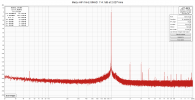He's not only saying that:What Sean is right about is that the tuning is only valid for one volume range. But that's true for everything in audio because we are always dealing with human perception. The volumes I use for testing are representative of what most people use when they listen to music.
So he's saying they're only maybe useful in terms of judging transducer frequency response within a frequency range that is flat on your equal loudness contour (otherwise you would not be able to differentiate between a change in loudness due to a change in your ear's sensitivity with frequency, and a change in loudness due to the frequency response of the transducer):Sine tones are good for identifying buzzes and rattles... and perhaps peaks/dips within a local frequency region where loudness sensitivity is constant.

That's not much of the contour at all (or it requires 'zooming in' until it's locally flat i.e. a sweep with a very small range of frequencies). Regardless, as he says there are much better ways to identify good spectral balance and resonances:
But there are more efficient ways to determine if the headphone has a smooth response/accurate spectral balance.In order of efficiency:
1) Measure it
2) listen to broadband pink noise -- the most sensitive signal for detecting low/medium/high Q resonances.
If you are trained you can identify the frequencies at which the resonances/anti-resonances occur. The more it rings or whistles the higher the Q
There's a perceptual difference between listening to a sine sweep of one frequency after another, which we do not intuitively know how it should sound because no natural sounds are anything like this, and we cannot differentiate between dips in our equal loudness contour and transducer resonances this way; and broadband sound like music composed of many different tones simultaneously, which we do know how it should sound, and for which our brain intuitively 'filters out' our equal loudness contour when listening for how 'correct' it sounds.Also, his comment about how using a tone sweep would lead to corrections that look like an equal loudness curve, so use music instead - what do you think music is? The result would be the same. It all has to pass through our ears.
Last edited:



